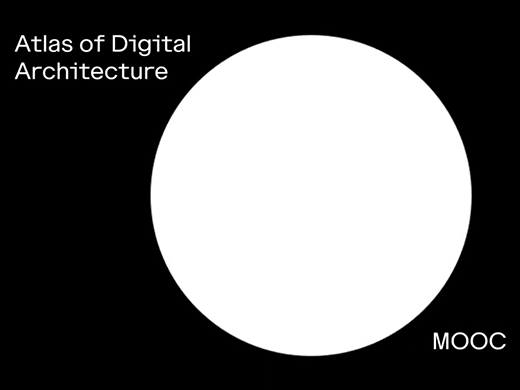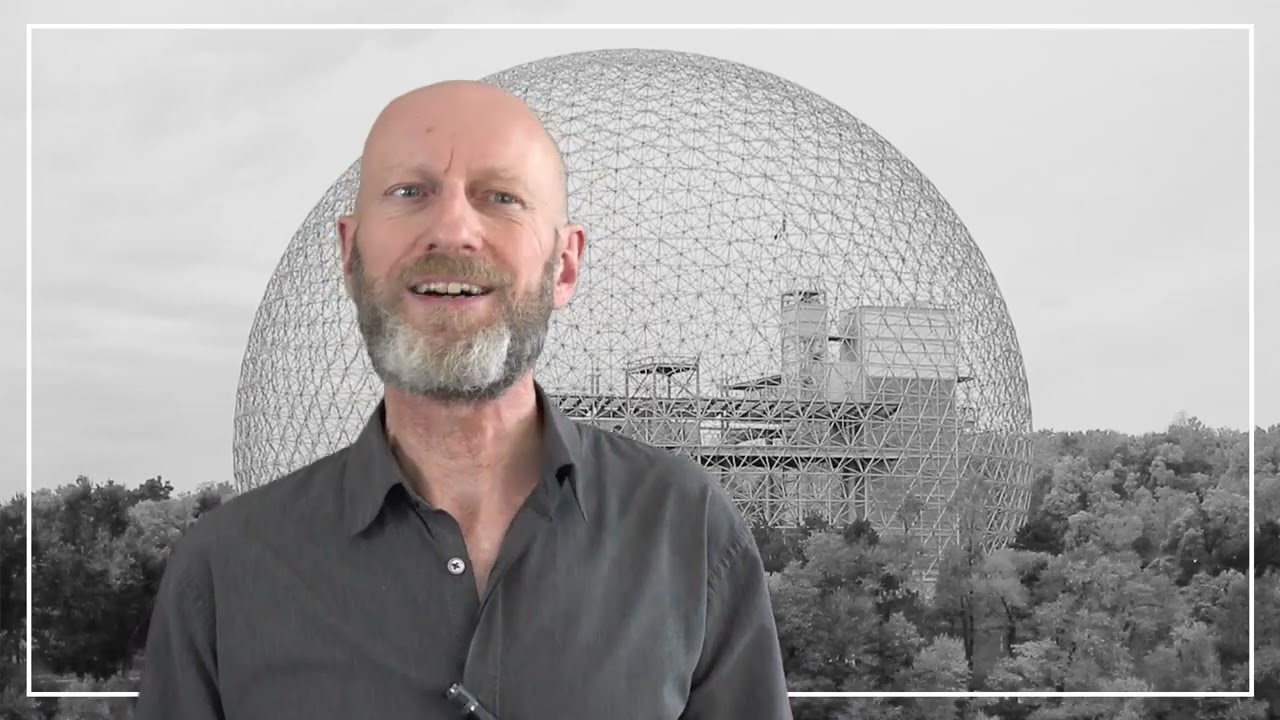Atlas of Digital Architecture - Part 2
Kursstart: 10. Mai 2023
Atlas of Digital Architecture - Part 2
Urs Hirschberg (TU Graz), Ludger Hovestadt (ETH Zürich), Oliver Fritz (HTWG Konstanz)
Dieser Kurs ist Teil einer MOOC-Serie: Atlas of Digital Architecture
Wissenschaftliche Einordnung:
Kursstart: 10. Mai 2023
Atlas of Digital Architecture - Part 2
Urs Hirschberg (TU Graz), Ludger Hovestadt (ETH Zürich), Oliver Fritz (HTWG Konstanz)
Dieser Kurs ist Teil einer MOOC-Serie: Atlas of Digital Architecture
-
Umfang: 5 Lektionen
-
Aufwand: 2 Stunden/Woche
-
Teilnehmende aktuell: 341
-
Lizenz: CC BY 4.0
-
Kursstart: 10. Mai 2023
-
Kursende: -
-
Status aktuell: Laufender Kurs
-
Verfügbare Sprachen:
Trailer
Details zum Kurs
Allgemeine Informationen zum Kurs
Digitale Technologie und Architektur sind untrennbar geworden, wobei neue Ansätze und Methoden nicht nur die Arbeitsabläufe und Praxis von Architektinnen und Architekten beeinflussen; sie verändern den Charakter der Architektur selbst. Dieses MOOC ist nach dem Atlas of Digital Architecture benannt, einem umfangreichen Lehrbuch über die unzähligen Arten und Weisen wie Computer heute in der Architektur verwendet werden. Durch eine Reihe von ansprechenden, episodischen online Vorträgen und Diskussionen, bietet dieser MOOC eine Einführung und Orientierung zu der faszinierenden und sich schnell ändernden Welt der digitalen Architektur.
Der Atlas of Digital Architecture, das Buch auf dem dieser MOOC basiert, vereint das Wissen von zwei Dutzend Professor*innen und Lehrenden an Universitäten und Hochschulen des deutschsprachigen Raums, von denen viele in diesem MOOC auftreten und ihre Expertise teilen. Das Buch wurde von Sebastian Michael, geschrieben, einem in London lebenden Autor, welcher auch in den Videos als Präsentator auftritt.
Dies ist Teil 2 in einer Reihe von fünf MOOCs, welche die Gruppe vorbereitet, um schließlich die gesamte thematische Breite des Atlas abzudecken. Jede der Lektionen bietet sowohl eine historische Perspektive als auch einen konzeptuellen Ausblick um einen Begriff der Kontinuität von Vergangenheit, Gegenwart und Zukunft zu vermitteln. Über ein normales Lehrbuch hinausgehend postuliert der Atlas auch einen theoretischen Rahmen für Architektur im 21sten Jahrhundert, was sich auch in diesem MOOC niederschlägt.
Der MOOC wird auf englisch präsentiert, wobei allerdings einige der Vorträge und alle Diskussionen deutsch sind. Wir empfehlen deswegen die Verwendung der Untertitel, welche für alle Videos sowohl in deutsch als auch in englisch verfügbar sind.
Kursinhalt
In sechs Teilen bietet der Atlas of Digital Architecture eine Orientierung für die unzähligen Arten und Weisen, wie der Computer heute in der Architektur verwendet wird, zum Beispiel: 3D Modeling und CAD, Rendering und Visualisierung, Scripting, Typographie, Text & Code, Digitale Fabrikation und Modellbau, GIS, BIM, Simulation, Big Data und Machine Learning, um nur einige zu nennen.
Dies ist das zweite von fünf MOOCs, welche die Autor*innen vorbereiten um
schließlich die gesamte inhaltliche Breite des Buches abzudecken. Genau wie die
Buchkapitel sind auch die Lektionen des MOOCs unabhängig voneinander und werden
nicht als Voraussetzung für andere Lektionen gesehen. Statt der Kapitelabfolge
des Buches zu folgen, bringt auch dieses zweite MOOC wieder Themen aus verschiedenen Teilen des Buches zusammen. Es beginnt mit einer Lektion zu Modellbau - wie digital gesteuerte Maschinen im Architekturmodellbau eingesetzt werden können. Eine der in Lektion 1 vorgestellten Techniken, der 3D Druck, wird dann in der zweiten Lektion noch vertieft. Dann folgt eine Lektion zum Thema GIS (Geografische Informationssysteme). In Lektion vier geht es um Typographie und Layout und in der abschliessenden fünften Lektion um Zusammenarbeit, also darum wie digitale Medien die Zusammenarbeit in der Architektur verändern.
Lernziele
Der Kurs vermittelt
eine Übersicht und ein grundlegendes Verständnis der behandelten Themen. Zu
jeder Lektion gehört sowohl ein Vortrag als auch eine informelle Diskussion
zwischen den Experten und Studierenden. Ein wichtiger Teil jeder Lektion ist
die historische Perspektive: Wie wurden die Methoden entwickelt, die derzeit
Stand der Technik sind? Welches waren ihre Vorläufer? Wann gab es wichtige
technische Durchbrüche? Zu jeder Lektion gehört auch ein Porträt einer beispielhaften
historischen Figur, welche wichtige Beiträge zur Entwicklung gemacht hat.
Im Kapitel über Model Making (Modellbau) wird die Art und Weise, wie Antoni Gaudi und Frei Otto beim Entwerfen mit Modellen gearbeitet haben vorgestellt. In der Lektion über GIS lernt man den GIS Pionier Jack Dangermond kennen, den Gründer der Firma ESRI. Aufbauend auf dieser historischen Perspektive lernen Teilnehmer wie eine bestimmte Methode oder Technologie gegenwärtig aussieht und benutzt wird und welche Auswirkungen dies auf die Architekturpraxis hat.
Die Lektionen sind informativ,
aber sie sollen auch zum Nachdenken anregen.
Vorkenntnisse
Dieser Kurs ist sowohl
für Architekturstudierende als auch für bereits im Beruf stehende Architektekt*innen
oder Designer*innen oder einfach an Gestaltung Interessierte gedacht. Außer Basiswissen über Computer und Interesse an
digitalen Methoden und Werkzeugen werden keine Vorkenntnisse vorausgesetzt.
Kursablauf
Der Kurs besteht aus fünf Lektionen, die im
Wochenrhythmus vorgestellt werden. Jede Lektion ist unabhängig und kann ohne
Vorkenntnisse aus einer der anderen Lektionen verstanden werden. Am Ende jeder
Lektion muss eine Reihe von Fragen beantwortet werden, welche das Verständnis
der vermittelten Inhalte überprüfen und zugleich konsolidieren.
Zertifikat
Für die aktive Teilnahme am Kurs erfolgt bei Abschluss die Ausstellung eines automatisierten Zertifikats, welches Ihren Benutzernamen, den Kursnamen und die abgeschlossenen Lektionen beinhalten. Es wird darauf hingewiesen, dass es sich nur um eine Bestätigung handelt, die aussagt, dass die Benutzerin oder der Benutzer zumindest 75% der gestellten Selbstüberprüfungsfragen richtig beantwortet hat.
Lizenz
Please credit Creative Commons - 4.0 International (CC BY 4.0) Atlas of Digital Architecture when reusing the material.
Kursleitung

Urs Hirschberg (TU Graz), Ludger Hovestadt (ETH Zürich), Oliver Fritz (HTWG Konstanz)
Dieser MOOC ist nach dem Atlas of Digital Architecture benannt, einem Lehrbuch das zwei Dutzend Professor*innen und Lehrende an Universitäten und Hochschulen des deutschsprachigen Raumes mit Hilfe des in London lebenden Autors Sebastian Michael verfasst haben, welcher auch in den Videos als Präsentator auftritt. Urs Hirschberg, Professor für Architektur und Medien an der TU Graz und einer der beitragenden Herausgeber des Buches, koordiniert die Produktion des MOOCs in enger Abstimmung mit den Co-Herausgebern Oliver Fritz (HTWG Konstanz) und Ludger Hovestadt (ETH Zürich).
Dies ist bereits der zweite Teil der Atlas of Digital Architecture MOOC Reihe. Neben Sebastian Michael und den Herausgebern tritt Peter Zeile (Karlsruhe Institute of Technology) als Experte auf. Die TU Graz Studierenden Sandra Sulzer und Nikolas Keuschnig sowie in manchen Lektionen die HTWG Konstanz Studierenden Fabian Braun und Nico Müller nehmen an den Diskussionen teil und tragen mit ihren Fragen zur Klärung der Themen bei.
Mehr Information zum Atlas und seine Herausgeber und Beitragenden findet man unter https://www.atlasofdigitalarchitecture.com/
Partner:innen
-

Technische Universität Graz


